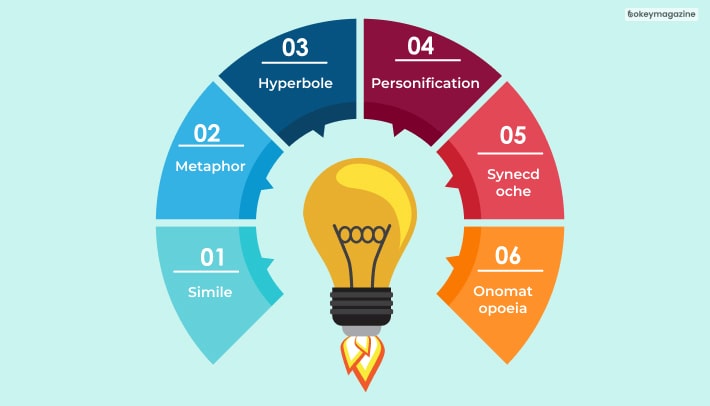
What Is Figurative Language And Examples Of Figurative Language?
In the English language, you are well aware of the term Figurative language, it is used when someone is expressing but does not use the feel’s realistic meaning. The word is not said literally.
The need for figurative language is to add a bit of creativity to the writing and the language to express quite a complicated feeling.
For example, let’s say someone says to you, “butterflies in their stomach” when they feel nervous; what does that mean? It doesn’t mean there are actual butterflies in someone’s stomach. The person is just expressing what they are feeling, and their body is feeling when they are quite nervous.
Understanding Figurative Language?

When you are talking to someone, there are times when you use some creative words or phrases to express a feeling that you are feeling. This is when you are using a phrase that is the stretched meaning of words you actually mean to say.
If you are an expert in the English language, then you should know that the opposite of figurative language is literal language. The meaning of literal language is that you say exactly what you feel and see, with no creativity in the meaning you are trying to express.
The Purpose Of Figurative Language

When you are using literal language, then it doesn’t evoke any amusement or engagement with the listener. But when you are using figurative language, then the meaning of the word you are trying to express is quite stretched out with a lot of creative words used in it.
The figurative language meaning is not quite as easily understood, but this language is very engaging with the audience and other listeners. Whereas literal languages are more for professional and academic communication and papers, figurative language is more conversational and amusing.
Types Of Figurative Language

When you are teaching figurative language, there are a couple of ways when you can use figurative language, and here are a few examples of the types of figurative language.
Simile
A simile is when you are comparing two different things together by using the words “as” or “like,” this is a common way of communicating with each other.
- “The new teacher is as tall as a giraffe.”
- “The boy was as brave as a lion in the jungle.”
Metaphor
A metaphor is as similar to a simile, but it just does not use certain words like “as” or “like.” That is the only difference between metaphor and simile.
- “Baby, you are my sunshine.”
- “I am drowning in grieve.”
Hyperbole
Hyperbole is the English language used to exaggerate a certain point and emphasize the point to bring a sense of humor and amusement to the speech.
- “You snore like a freight train.”
- “I have told you a million times to wash the dishes.”
Personification
A personification is when you are comparing a non-human thing with an actual human. This is when you can compare the two aspects.
- “The radio stared at me.”
- “The car stopped with a groaning complaint.”
Synecdoche
When you are talking about a synecdoche, then you should know that it is like figurative language that uses one part to refer to a whole or the whole to refer to the part.
- “Bread can be used to refer to food in general or money.”
- “Hired hands can be used to refer to workers.”
Onomatopoeia
This English language is that names something or does an act by imitating the particular sound it is associated with. This way, you add a certain drama or reality to your writing.
- “The truck engine roared as it climbed the hill.”
- “The fireplace heater hissed and cracked.”
How Is Figurative Language Used In Storytelling?
If it is not already clear, figurative language is a very important tool for anyone who wishes to tell a story or make a point. It adds depth, color, and understanding of one’s emotions.
In short, it adds the human element to storytelling. This is primarily important when a story is placed in an unfamiliar setting as it helps the reader relate to the plot or the characters.
Let us now explore some of the areas where figurative language is used to give any story more depth and understanding.
The Relation Between Figurative Writing And Imagery
Figurative writing is a great way to develop imagery within a piece of writing; however, it is not an essential component.
Imagery is defined as the way a storyteller paints a picture for the readers. It makes the reader feel like they can experience what the storyteller is saying and understand it just the way they are describing it.
Figurative language helps the reader see the places, characters, and actions in their mind.
Figurative Language And Humor
Humorous texts are the best areas where a storyteller may use their figurative language skills. They may understand or grossly overstate the setting or the situation.
For instance, Terry Pratchett’s The Light Fantastic has this portion-
“Rincewind wasn’t certain about what happened to you after you really died, the authorities were a little unclear on the subject; a swarthy sailor from the Rimward lands had said that he was confident of going to a paradise where there was sherbet and houris. Rincewind wasn’t certain what an houri was, but after some thought he came to the conclusion that it was a little liquorice tube for sucking up the sherbet. Anyway, sherbet made him sneeze.”
Bring The Character To Life
Hyperbole or exaggerated statements are really effective figurative language that adds a good effect to the characters by adding colors to their traits or actions.
Here is yet another portion from Terry Pratchett,
“Galder Weatherwax, Supreme Grand Conjuror of the Order of the Silver Star, Lord Imperial of the Sacred Staff, Eighth Level Ipsissimus and 304th Chancellor of Unseen University, wasn’t simply an impressive sight even in his red nightshirt with the hand-embroidered mystic runes, even in his long cap with the bobble on, even with the Wee Willie Winkie candlestick in his hand. He even managed to very nearly pull it off in fluffy pompom slippers as well.”
Developing Compelling Settings Using Metaphors And Similes
If you want to see the perfect example of it, this is how Dan Brown has described the Guggenheim Museum in Origin.
“The Guggenheim Museum in Bilbao, Spain, looked like something out of an alien hallucination-a swirling collage of warped metallic forms that appeared to have been propped up against one another in an almost random way. Stretching into the distance, the chaotic mass of shapes was draped in more than thirty thousand titanium tiles that glinted like fish scales and gave the structure a simultaneously organic and extraterrestrial feel, as if some futuristic leviathan had crawled out of the water to sun herself on the riverbank.”
How To Use Figurative Language In Your Own Writing?

Whenever you are writing a piece of writing, then you by using certain languages, such as figurative language and literal language, can enhance your writing to the next level.
Whenever you are using any figurative language, you should control your urge to use more figurative language. These languages can be a lot distracting while reading, so whenever you are using them, keep yourself in control.
1. Use Language Sparingly
Like I said before, you need to be very careful while using Figurative language, as it can overpower your whole writing and ruin the whole purpose of the writing.
2. This Language Pairs Well With Humor
Whenever you are trying to write an engaging article, you should know that you can easily create a humorous article by using these figurative languages, as they go great with each other.
3. Be Careful While Using It As A Dialogue
When writing something that contains dialogues, it is very easy to go with the flow and use as much figurative language, but you need to be careful while using that.
These flowery phrases can be very attractive and enhance your writing, but they can even distract the readers from understanding the meaning of the sentence.
4. Never Sacrifice Clarity
Since figurative language is a stretched-out phrase of the actual meaning you mean to say. But you should never allow yourself to sacrifice the clarity of a sentence by using figurative language, or else you can disrupt the flow for your readers.
Frequently Asked Questions:-
If you have any more queries related to the topic then, then here are some questions that other people have asked.
Ans: Here are the 5 types of figurative language are:
⦿ Metaphor
⦿ Allusion
⦿ Implied metaphor
⦿ Simile
⦿ Hyperbole
⦿ Personification
Ans: Here are 5 examples of Hyperbole are:
⦿ “Cry me a river.”
⦿ “I’ve told you this 20,000 times.”
⦿ “The pen is mightier than the sword.”
⦿ “My feet are killing me.”
⦿ “I’m so hungry, I could eat a horse.”
Ans: Here are 5 examples of metaphor are:
⦿ “Life is a highway.”
⦿ “Her eyes were diamonds.”
⦿ “He is a shinning star.”
⦿ “She is an early bird.”
⦿ “The snow is a white blanket.”
Wrapping Up!
Now that you are aware of what figurative language is, and how it is used in different ways in different sentences, you can use it as well. Figurative languages are very creative in their approach and enhance your writing.
If you find this article helpful for you to understand the teaching of figurative language, then like the article and comment down below to let me know.
Keep Reading:



















Post Your Comment